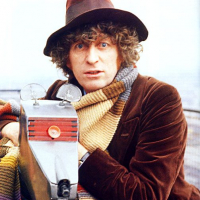TDF 2018, Stage 9: Arras Citadelle > Roubaix 15/07/2018 - 156,5 km *Spoilers*

blazing_saddles
Posts: 22,725
Arras Citadelle > Roubaix 15/07/2018 - Stage 9 - 156,5 km
At 156.5 kilometres, the 9th stage of the Tour de France is bound to bring spectacle. The route runs from Arras to Roubaix and takes in fifteen stretches of pavé.
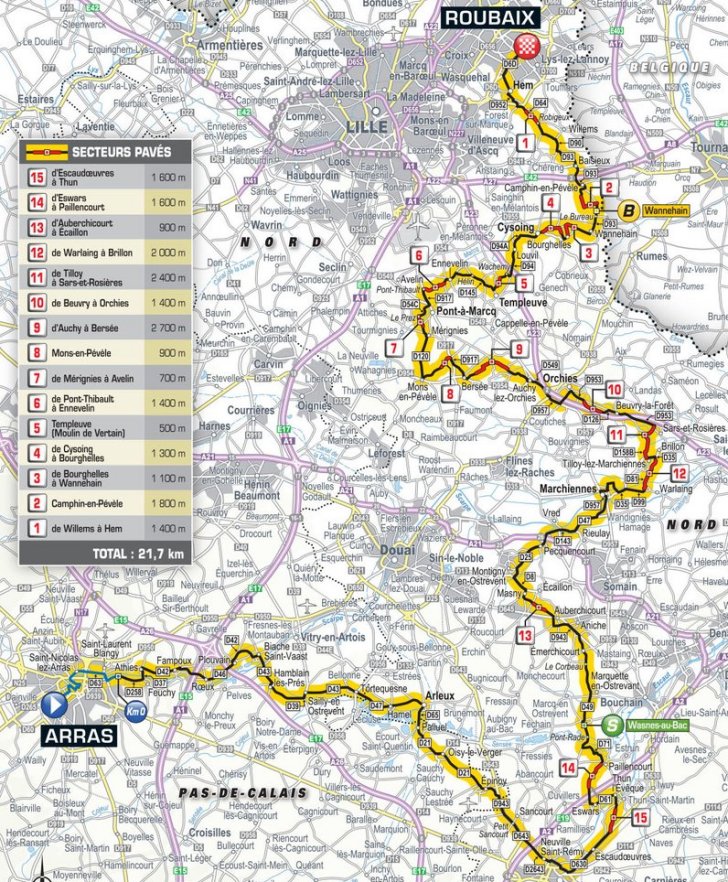
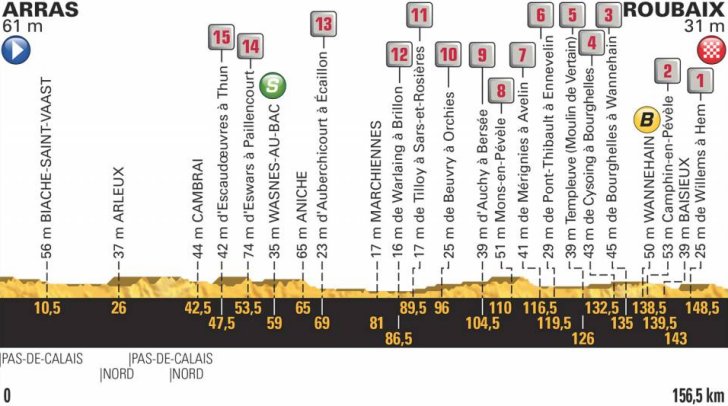
The route between Arras and Cambrai takes in Athies, Fampous, Roeux, Plouvain, Biache-Saint-Vaast, Hamblain-les-Prés, Sailly-en-Ostrevent, Tortequesne, Hamel, and Arleux. Between Arleux and Palleul. The route swaps from the Pas-de-Calais département to the Nord, then back again into Pas-de-Calais. It crosses the Canal du Nord, then passes Oisy-le-Verger, and Epinoy, before entering the Nord again
Approaching Cambrai, the race passes through the northern suburb of Neuville-Saint-Rémy, and skirts around the town to the north on the D243 (a major, wide road). The riders leave Cambrai on the D630 avenue de Valenciennes, heading for Escaudoeuvres. Positioning will be important here, before the first cobbled section from Escaudoeuvres to Thun.
The cobbled stage in the 2018 Tour de France features fifteen stretches of pavé. Totalling at 21.7 kilometres this is the greatest distance of cobbles included in the Tour’s last five ventures onto the pavé.
These are the fifteen cobbled sections:
Escaudoeuvres to Thun (1,600m)
Eswars to Paillencourt (1,600m)
Auberchicourt to Ecaillon (900m)
Warlaing to Brillon (2,000m)
Tilloy to Sars-et-Rosières (2,400m)
Beuvry to Orchies (1,400m)
Auchy to Bersée (2,700m)
Mons-en-Pévèle (900m)
Mérignies to Avelin (700m)
Pont-Thibault to Ennevelin (1,400m)
Templeuve (500m)
Cysoing to Bourghelles (1,300m)
Bourghelles to Wannehain (1,100m)
Camphin-en-Pévèle (1,800m)
Willems à Hem (1,400m)

The highest cobble density is between kilometre 84.5 and kilometre 137 as this section takes in eleven stretches of pavé with the last one Camphin-en-Pévèle. In that same order the sections were included in the 2017 edition of Paris-Roubaix, but while the riders continued to Carrefour de l’Arbre after Camphin-en-Pévèle, they now head for Willems à Hem, which is the final pavé of this year’s Tour de France. It amounts to 1.4 kilometre before the riders leave the cobbles behind with 8 kilometres remaining.
Arriving at the southern suburb of Hem, the race route takes boulevard Clémenceau, then avenue Charles de Gaulle/avenue Alfred Motte. It then goes along rue de Lannoy, rue Robert Schuman, and avenue de Verdun, before reaching the finish line at avenue Maxence van der Meersch, by the Velodrome. The finish is not inside but just outside the Roubaix Velodrome.
Video of the last 5kms.
https://youtu.be/DHJdEkqWJME
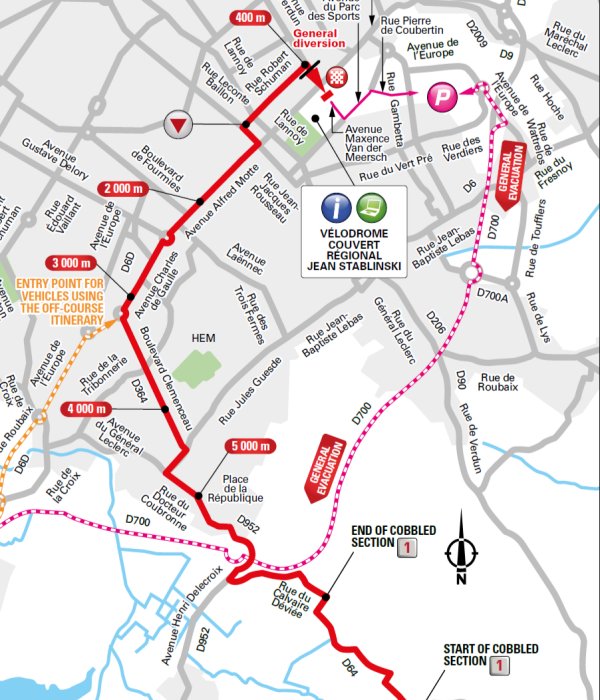
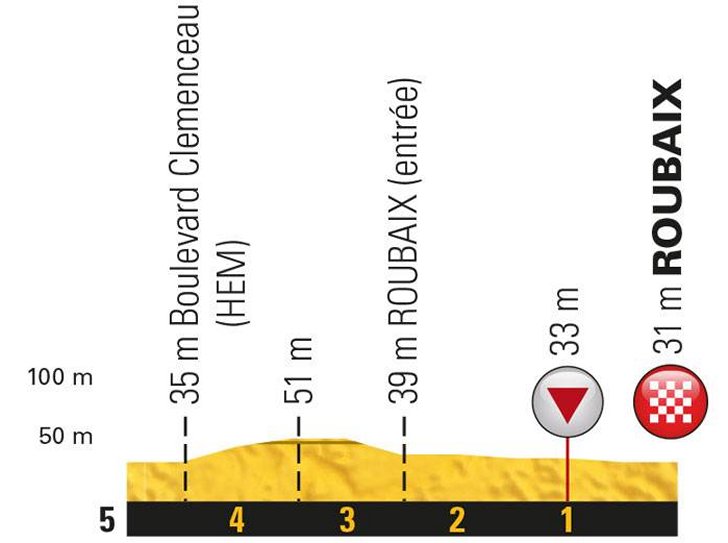
In 1979, Bernard Hinault lost three minutes on them after puncturing twice, though he went on to win his second Tour.
More recently, in 2014, Vincenzo Nibali added a little more luster to his yellow jersey by taking a major advantage on the stones. Leader of the general classification since stage 2, the Italian put in an amazing ride, reaching the finish at the start of Roubaix’s infamous Arenberg Forest section in third place, just 19 seconds behind stage winner Lars Boom. More significantly, he was well ahead of his rivals for the overall title. In doing so, he laid the foundations for his final victory.
The 9th stage of the 2018 Tour de France starts at 12:50 and the finish is expected around 16:18cet.
Favourites 9th stage 2018 Tour de France
*** Niki Terpstra, Peter Sagan, Greg Van Avermaet, Sep Vanmarcke
** Jasper Stuyven, Edvald Boasson Hagen, Alexander Kristoff, John Degenkolb
* Oliver Naesen, Søren Kragh Andersen, Arnaud Démare, Michael Valgren Andersen
The team hotels for this stage are after an air transfer.
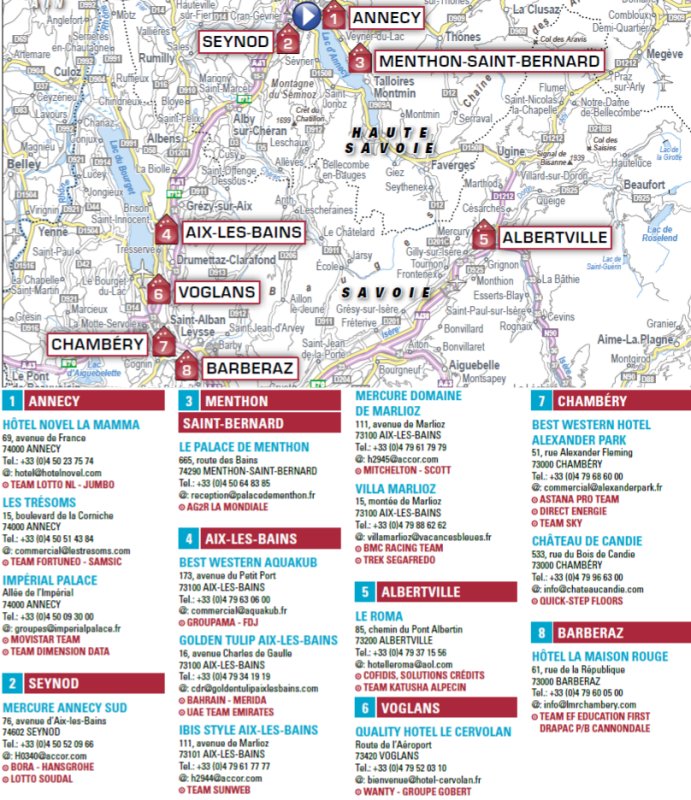
Arras Citadelle
4 previous stages
Prefecture of Pas-de-Calais (62)
42,000 inhabitants (Arrageois)
107,582 inhabitants within the 39 communes of Arras Urban Community
The Grand Place and Place des Héros are connected by the Rue de la Taillerie, these two squares were designed to accommodate markets from the 11th century onwards and comprise a unique architectural ensemble with 17,000m2 of cobbles. They are surrounded by the façades of 155 houses built in Flemish Baroque style.
The town hall’s belfry was built between 1463 and 1554, but destroyed during the First World War, it was rebuilt identically. Arras’ belfry is classified as a UNESCO World Heritage site along with 22 other belfries in France and Belgium.
The citadel was built between 1668 and 1672 to protect the kingdom against invasion from the Spanish Netherlands, it was never attacked and was therefore nicknamed “the beautifully pointless”. It has been classified as a UNESCO World Heritage site since 2008.
The British military cemetery, Arras Memorial comprises the tombs of 2,652 Commonwealth soldiers and a few German prisoners of war. The compound’s wall bears the names of the 35,928 fighters from Britain, New Zealand and South Africa killed in the Arras area and whose bodies were never found.


ARRAS AND CYCLING
The firs appearance of Arras on the Tour de France map was 27 years ago for a stage leading to Le Havre. That day, on July 11, 1991, Frenchman Thierry Marie looked especially eager to return to his native Normandy.
Having escaped after just 25 of this 259km-long stage that began in Arras, the prologue winner spent 234km all alone at the front to win in Le Havre, where he was 1-54 ahead of the pack and took the yellow jersey back from Greg LeMond. He was alone to an extent, but not quite... Close to him in the team director’s car that day was team manager Cyrille Guimard’s deputy, Bernard Quilfen, who had carried out his own long-range raid of 222km in 1977. Marie pulled off the second longest solo break in Tour history after the 253km that Albert Bourlon covered in 1947 between Carcassonne and Luchon. The stage also started without a yellow jersey as Greg LeMond had refused to wear it after the crash and abandon of Dane Rolf Sorensen, its previous holder, the day before. In 2004, a few days after the first edition of the Main Square Festival, Arras hosted the finish of the team time trial that the US Postal team won in crushing fashion. A Paris-Arras race took place between 1923 and 1959, and was revived in 2010 as the Paris-Arras Tour.
In 2015, Arras was the start of a stage to Amiens won by Germany’s Andre Greipel.
Specialities: andouillette, Coeur d'Arras (cheese), Bleu d'Arras, porcelain.
Arras andouillette, also known as penis and chips....

Or without.
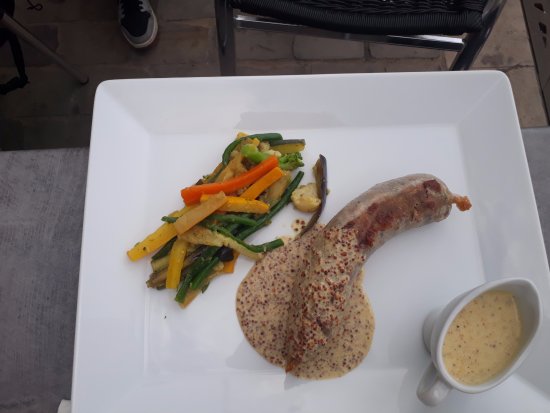
Roubaix
25 previous stages
Commune in the Nord department
96,650 inhabitants (Roubaisians)
ROUBAIX AND CYCLING
Roubaix was once dubbed “the French Manchester” for its role in the world’s textile industry in the 19th century. The town also became the capital of cycling in Spring, but also in July when the Tour de France tackles the cobbles of the Queen of Classics. In the rain, like in 2014 when Lars Boom took the stage honours, or in the dust, like in 2015 when Tony Martin raised his arms in Roubaix, the magic of the cobbles also operates in the summer. Cobbles are sometimes described as foreign to the spirit of the Tour but it is a gross misinterpretation as they have always been part of the Tour itinerary. If there were no cobbles on the race between 1989 and 2004, it was only a short break in the history of the race. Between 1934 and 1937, the Tour started by two days in the Hell of the North with stages between Paris and Lille and Lille and Charleville. Georges Speicher lost the crown he had won in 1933 on the cobbles. In 1949, the riders had to tackle 100 km of cobbles. Jean Robic lost eight minutes. As for Fausto Coppi and Gino Bartali, they usually took it easy in the slippery stages of the north, saving their strength for the mountains. Among the riders to have seen their hopes quashed by the cobbles can be mentioned René Privat and François Mahé in 1961, Frank Schleck in 2010 but also Jan Raas in 1979, Marc Gomez in 1983 oe Iban Mayo in 2004. Other riders made a name for themselves on the Tour cobbles, like Seamus Elliott, the first Irishman to hold the yellow jersey in 1963. Only the improvement of the tarmac made cobbles obsolete but they never totally left the Tour route. Some of the race’s greatest moments took place on the rugged terrain, like in 1970 when Roger de Vlaeminck won in Valenciennes or in 1980 when Bernard Hinault raised his arms in Lille. In 1979, the Badger had lost a lot of time in the cobbles only to strike back and win both Paris-Roubaix and that Tour stage. As for Jan Raas, who also crashed in 1979, he won the Lille-Lille stage in 1982 and Paris-Roubaix the same year.
Specialities: moules-frites (mussels and chips), fricadelle (sausage), carbonade (beer stew), chicory, pavé de Roubaix (cheese), stuffed waffles, beer.

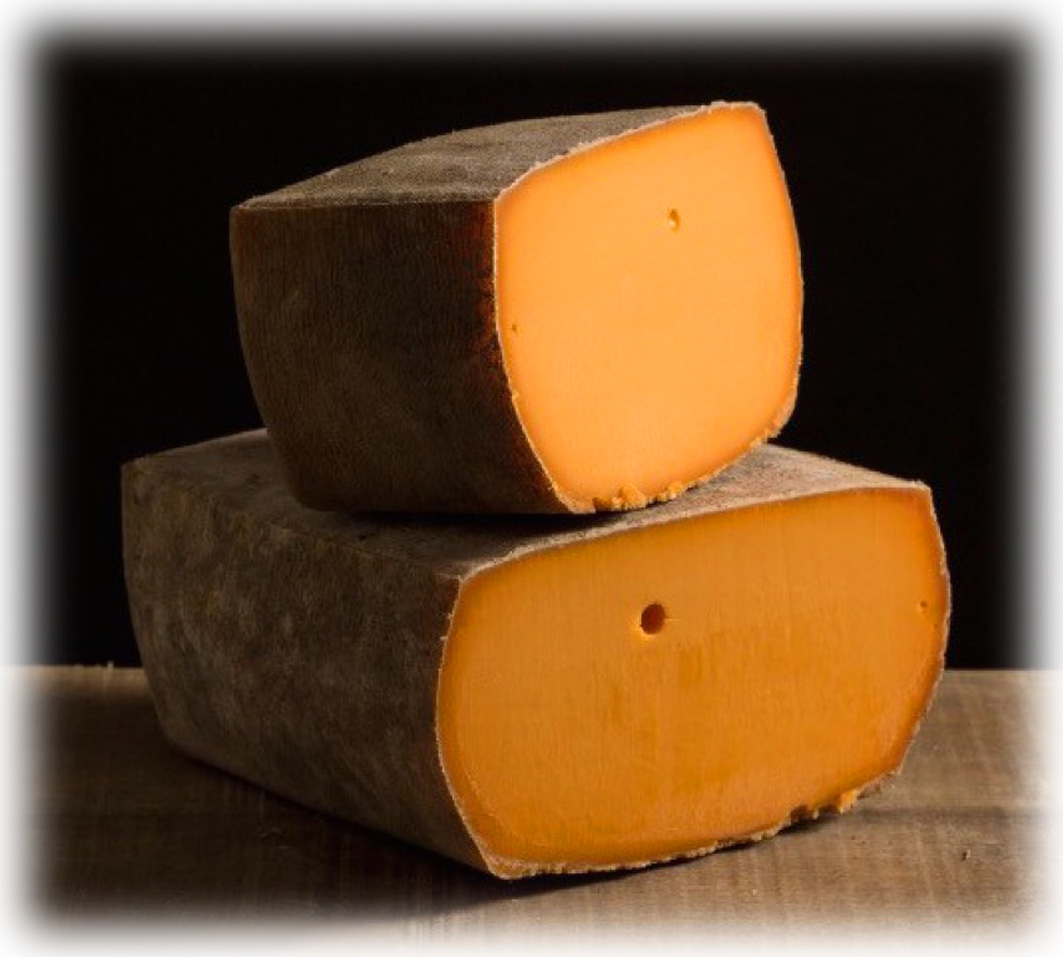

At 156.5 kilometres, the 9th stage of the Tour de France is bound to bring spectacle. The route runs from Arras to Roubaix and takes in fifteen stretches of pavé.


The route between Arras and Cambrai takes in Athies, Fampous, Roeux, Plouvain, Biache-Saint-Vaast, Hamblain-les-Prés, Sailly-en-Ostrevent, Tortequesne, Hamel, and Arleux. Between Arleux and Palleul. The route swaps from the Pas-de-Calais département to the Nord, then back again into Pas-de-Calais. It crosses the Canal du Nord, then passes Oisy-le-Verger, and Epinoy, before entering the Nord again
Approaching Cambrai, the race passes through the northern suburb of Neuville-Saint-Rémy, and skirts around the town to the north on the D243 (a major, wide road). The riders leave Cambrai on the D630 avenue de Valenciennes, heading for Escaudoeuvres. Positioning will be important here, before the first cobbled section from Escaudoeuvres to Thun.
The cobbled stage in the 2018 Tour de France features fifteen stretches of pavé. Totalling at 21.7 kilometres this is the greatest distance of cobbles included in the Tour’s last five ventures onto the pavé.
These are the fifteen cobbled sections:
Escaudoeuvres to Thun (1,600m)
Eswars to Paillencourt (1,600m)
Auberchicourt to Ecaillon (900m)
Warlaing to Brillon (2,000m)
Tilloy to Sars-et-Rosières (2,400m)
Beuvry to Orchies (1,400m)
Auchy to Bersée (2,700m)
Mons-en-Pévèle (900m)
Mérignies to Avelin (700m)
Pont-Thibault to Ennevelin (1,400m)
Templeuve (500m)
Cysoing to Bourghelles (1,300m)
Bourghelles to Wannehain (1,100m)
Camphin-en-Pévèle (1,800m)
Willems à Hem (1,400m)

The highest cobble density is between kilometre 84.5 and kilometre 137 as this section takes in eleven stretches of pavé with the last one Camphin-en-Pévèle. In that same order the sections were included in the 2017 edition of Paris-Roubaix, but while the riders continued to Carrefour de l’Arbre after Camphin-en-Pévèle, they now head for Willems à Hem, which is the final pavé of this year’s Tour de France. It amounts to 1.4 kilometre before the riders leave the cobbles behind with 8 kilometres remaining.
Arriving at the southern suburb of Hem, the race route takes boulevard Clémenceau, then avenue Charles de Gaulle/avenue Alfred Motte. It then goes along rue de Lannoy, rue Robert Schuman, and avenue de Verdun, before reaching the finish line at avenue Maxence van der Meersch, by the Velodrome. The finish is not inside but just outside the Roubaix Velodrome.
Video of the last 5kms.
https://youtu.be/DHJdEkqWJME


In 1979, Bernard Hinault lost three minutes on them after puncturing twice, though he went on to win his second Tour.
More recently, in 2014, Vincenzo Nibali added a little more luster to his yellow jersey by taking a major advantage on the stones. Leader of the general classification since stage 2, the Italian put in an amazing ride, reaching the finish at the start of Roubaix’s infamous Arenberg Forest section in third place, just 19 seconds behind stage winner Lars Boom. More significantly, he was well ahead of his rivals for the overall title. In doing so, he laid the foundations for his final victory.
The 9th stage of the 2018 Tour de France starts at 12:50 and the finish is expected around 16:18cet.
Favourites 9th stage 2018 Tour de France
*** Niki Terpstra, Peter Sagan, Greg Van Avermaet, Sep Vanmarcke
** Jasper Stuyven, Edvald Boasson Hagen, Alexander Kristoff, John Degenkolb
* Oliver Naesen, Søren Kragh Andersen, Arnaud Démare, Michael Valgren Andersen
The team hotels for this stage are after an air transfer.

Arras Citadelle
4 previous stages
Prefecture of Pas-de-Calais (62)
42,000 inhabitants (Arrageois)
107,582 inhabitants within the 39 communes of Arras Urban Community
The Grand Place and Place des Héros are connected by the Rue de la Taillerie, these two squares were designed to accommodate markets from the 11th century onwards and comprise a unique architectural ensemble with 17,000m2 of cobbles. They are surrounded by the façades of 155 houses built in Flemish Baroque style.
The town hall’s belfry was built between 1463 and 1554, but destroyed during the First World War, it was rebuilt identically. Arras’ belfry is classified as a UNESCO World Heritage site along with 22 other belfries in France and Belgium.
The citadel was built between 1668 and 1672 to protect the kingdom against invasion from the Spanish Netherlands, it was never attacked and was therefore nicknamed “the beautifully pointless”. It has been classified as a UNESCO World Heritage site since 2008.
The British military cemetery, Arras Memorial comprises the tombs of 2,652 Commonwealth soldiers and a few German prisoners of war. The compound’s wall bears the names of the 35,928 fighters from Britain, New Zealand and South Africa killed in the Arras area and whose bodies were never found.


ARRAS AND CYCLING
The firs appearance of Arras on the Tour de France map was 27 years ago for a stage leading to Le Havre. That day, on July 11, 1991, Frenchman Thierry Marie looked especially eager to return to his native Normandy.
Having escaped after just 25 of this 259km-long stage that began in Arras, the prologue winner spent 234km all alone at the front to win in Le Havre, where he was 1-54 ahead of the pack and took the yellow jersey back from Greg LeMond. He was alone to an extent, but not quite... Close to him in the team director’s car that day was team manager Cyrille Guimard’s deputy, Bernard Quilfen, who had carried out his own long-range raid of 222km in 1977. Marie pulled off the second longest solo break in Tour history after the 253km that Albert Bourlon covered in 1947 between Carcassonne and Luchon. The stage also started without a yellow jersey as Greg LeMond had refused to wear it after the crash and abandon of Dane Rolf Sorensen, its previous holder, the day before. In 2004, a few days after the first edition of the Main Square Festival, Arras hosted the finish of the team time trial that the US Postal team won in crushing fashion. A Paris-Arras race took place between 1923 and 1959, and was revived in 2010 as the Paris-Arras Tour.
In 2015, Arras was the start of a stage to Amiens won by Germany’s Andre Greipel.
Specialities: andouillette, Coeur d'Arras (cheese), Bleu d'Arras, porcelain.
Arras andouillette, also known as penis and chips....

Or without.

Roubaix
25 previous stages
Commune in the Nord department
96,650 inhabitants (Roubaisians)
ROUBAIX AND CYCLING
Roubaix was once dubbed “the French Manchester” for its role in the world’s textile industry in the 19th century. The town also became the capital of cycling in Spring, but also in July when the Tour de France tackles the cobbles of the Queen of Classics. In the rain, like in 2014 when Lars Boom took the stage honours, or in the dust, like in 2015 when Tony Martin raised his arms in Roubaix, the magic of the cobbles also operates in the summer. Cobbles are sometimes described as foreign to the spirit of the Tour but it is a gross misinterpretation as they have always been part of the Tour itinerary. If there were no cobbles on the race between 1989 and 2004, it was only a short break in the history of the race. Between 1934 and 1937, the Tour started by two days in the Hell of the North with stages between Paris and Lille and Lille and Charleville. Georges Speicher lost the crown he had won in 1933 on the cobbles. In 1949, the riders had to tackle 100 km of cobbles. Jean Robic lost eight minutes. As for Fausto Coppi and Gino Bartali, they usually took it easy in the slippery stages of the north, saving their strength for the mountains. Among the riders to have seen their hopes quashed by the cobbles can be mentioned René Privat and François Mahé in 1961, Frank Schleck in 2010 but also Jan Raas in 1979, Marc Gomez in 1983 oe Iban Mayo in 2004. Other riders made a name for themselves on the Tour cobbles, like Seamus Elliott, the first Irishman to hold the yellow jersey in 1963. Only the improvement of the tarmac made cobbles obsolete but they never totally left the Tour route. Some of the race’s greatest moments took place on the rugged terrain, like in 1970 when Roger de Vlaeminck won in Valenciennes or in 1980 when Bernard Hinault raised his arms in Lille. In 1979, the Badger had lost a lot of time in the cobbles only to strike back and win both Paris-Roubaix and that Tour stage. As for Jan Raas, who also crashed in 1979, he won the Lille-Lille stage in 1982 and Paris-Roubaix the same year.
Specialities: moules-frites (mussels and chips), fricadelle (sausage), carbonade (beer stew), chicory, pavé de Roubaix (cheese), stuffed waffles, beer.



"Science is a tool for cheaters". An anonymous French PE teacher.
0
Comments
-
Anyone got a star rating for the pavé?Warning No formatter is installed for the format0
-
Surely some of those you have as favourites will not have the freedom as if this were a one-day classic, rather they may have to 'protect' their GC-man.
In particular, this may apply to GVA, Vanmarcke, Naesen and both Andersens, and possibly also to Stuyven or Degenkolb and Kristoff. I'd guess it also applies to riders who otherwise could do well, like Erviti (Movistar).
Although on the other hand, I can imagine some potential winners may be given the freedom of the day if their team has enough strong others to protect their GC-man, e.g. Thomas or Moscon.
And maybe the favourites should include the likes of Lampaert (as alternate to Terpstra) and also Nibali, since his Tour win was founded on the cobbles (I'd guess this stage played a role in his reason to participate in the Tour this year, hoping for a repeat performance).
In fact I wonder if any of the other GC-men will try to use the stage as a leaping stone.0 -
Weather forecast - low wind, low chance of precipitation. Nice and dry and dusty
Haven't managed to find a star rating no, I'm sure you could find out if you cross referenced the sectors with the list from Paris Roubaix perhaps, but even then the sectors are adapted for the tour so it wouldn't be 100% accurate0 -
ShutupJens wrote:Haven't managed to find a star rating no, I'm sure you could find out if you cross referenced the sectors with the list from Paris Roubaix perhaps, but even then the sectors are adapted for the tour so it wouldn't be 100% accurate
Yeah, I started doing that then gave up.Warning No formatter is installed for the format0 -
Just ask Greased Scotsman, he knows them off by heart0
-
knedlicky wrote:Surely some of those you have as favourites will not have the freedom as if this were a one-day classic, rather they may have to 'protect' their GC-man.
In particular, this may apply to GVA, Vanmarcke, Naesen and both Andersens, and possibly also to Stuyven or Degenkolb and Kristoff. I'd guess it also applies to riders who otherwise could do well, like Erviti (Movistar).
That was my thinking so went for EBH in PTP with Terpstra having been the other I was considering. Hopefully Geraint will have a free reign and is surely the best suited of the potential GC contenders although it will be interesting to see how Dumoulin copes.0 -
Following on from the post above, who do we think out of the GC contenders will do well on the cobbles and who will have a real struggle?
Mishaps excepted G should do well along with Valverde. I actually think Froome might do OK as well as Dumoulin. Not sure about Bardet but I can see Dan Martin suffering after today and Quintana hating it. Yates is a bit of a dark horse, should struggle but has some good help similar with Titchie Richie. Not sure about Uran, I actually think he might do well.0 -
Nibali, surely should go well.
Kruijswijk and Roglic you would think, but then again, it is Lotto Jumbo we are talking about."Science is a tool for cheaters". An anonymous French PE teacher.0 -
From the Eurosport stage preview:
** Escaudoeuvres to Thun (1,600m)
** Eswars to Paillencourt (1,600m)
** Auberchicourt to Ecaillon (900m)
*** Warlaing to Brillon (2,000m)
**** Tilloy to Sars-et-Rosières (2,400m)
*** Beuvry to Orchies (1,400m)
**** Auchy to Bersée (2,700m)
** Mons-en-Pévèle (900m)
** Mérignies to Avelin (700m)
*** Pont-Thibault to Ennevelin (1,400m)
** Templeuve (500m)
*** Cysoing to Bourghelles (1,300m)
*** Bourghelles to Wannehain (1,100m)
**** Camphin-en-Pévèle (1,800m)
*** Willems à Hem (1,400m)"Science is a tool for cheaters". An anonymous French PE teacher.0 -
Fuglsang is a good shout for a GC contender. Has a Paris-Roubaix top 20 to his name, rode for Nibali when Nibali took time last time the Tour rode cobbles, and has Valgren with him who can do some damage. He also needs to take some time here if he wants a good placing, as he's OK but not exceptional in the mountains.
Oh and just for a heads up, Tony Martin came in last place today, 11'05" down. Saving a bit of oomph for tomorrow?Warning No formatter is installed for the format0 -
Blazing Saddles wrote:From the Eurosport stage preview:
** Escaudoeuvres to Thun (1,600m)
** Eswars to Paillencourt (1,600m)
** Auberchicourt to Ecaillon (900m)
*** Warlaing to Brillon (2,000m)
**** Tilloy to Sars-et-Rosières (2,400m)
*** Beuvry to Orchies (1,400m)
**** Auchy to Bersée (2,700m)
** Mons-en-Pévèle (900m)
** Mérignies to Avelin (700m)
*** Pont-Thibault to Ennevelin (1,400m)
** Templeuve (500m)
*** Cysoing to Bourghelles (1,300m)
*** Bourghelles to Wannehain (1,100m)
**** Camphin-en-Pévèle (1,800m)
*** Willems à Hem (1,400m)
Cheers, just what I was after.
BTW - the last cobbles are just 8km from the finish - there's very little asphalt to take back any time you lose on the pavé - so best ride them well.Warning No formatter is installed for the format0 -
Other titbits of info...
Sky and Bora share a hotel the night before this. Froome and Sagan have had fun together before. If I was Sky DS and wanted to do some damage tomorrow I might stroll down the corridor and have a wee chat.
Thing with cobbled stages is they aren't classics, they aren't really ridden the same way. Yes there will be a fight for position before each section, but is anyone going to really drill it and force a selection, and then do it again, and again, until it sticks?Warning No formatter is installed for the format0 -
Another titbit. Order for team car support for tomorrow - not grand for Bardet if he has any issues ...
 0
0 -
No tA Doctor wrote:Fuglsang is a good shout for a GC contender. Has a Paris-Roubaix top 20 to his name, rode for Nibali when Nibali took time last time the Tour rode cobbles, and has Valgren with him who can do some damage. He also needs to take some time here if he wants a good placing, as he's OK but not exceptional in the mountains.
Oh and just for a heads up, Tony Martin came in last place today, 11'05" down. Saving a bit of oomph for tomorrow?
Tony Martin did a superman during the crash, lots of same video on social media, he'll be a bit beaten up.0 -
Blazing Saddles wrote:Nibali, surely should go well.
Kruijswijk and Roglic you would think, but then again, it is Lotto Jumbo we are talking about.
Meant to include Nibali. Was it P-R or RVV where he went well in the spring?
I thought about Roglic but he's quite lightweight and as far as I know doesn't have cobble experience so actually thought he might struggle but has a bit of experience around him.0 -
its dry and not much wnd forecast i predict a mahoosive pileup at some point. But accidents apart the GC riders will be ok. They have team mates to help them.
I expect Quick step will win the stage.0 -
Pross wrote:Blazing Saddles wrote:Nibali, surely should go well.
Kruijswijk and Roglic you would think, but then again, it is Lotto Jumbo we are talking about.
Meant to include Nibali. Was it P-R or RVV where he went well in the spring?
I thought about Roglic but he's quite lightweight and as far as I know doesn't have cobble experience so actually thought he might struggle but has a bit of experience around him.
RVV and then straight on the plane to one of the short stage races0 -
Courtesy of Inrng, the turn into the first section tomorrow. :shock:

What it will look like after: Warning No formatter is installed for the format0
Warning No formatter is installed for the format0 -
Im assuming the forecast for tomorrow is dry? if so its a different proposition for Froome than the last time he faced the cobbles. That said I'm sure its going to be chaos anyway.0
-
daninexile wrote:Im assuming the forecast for tomorrow is dry? if so its a different proposition for Froome than the last time he faced the cobbles. That said I'm sure its going to be chaos anyway.
The last time he rode cobbles in the tour he attacked late in the stage."Unfortunately these days a lot of people don’t understand the real quality of a bike" Ernesto Colnago0 -
No tA Doctor wrote:Courtesy of Inrng, the turn into the first section tomorrow. :shock:

What it will look like after:
Right turn in or left? A right turn would at least slow them right down but it will cause a big battle for a few kms beforehand.0 -
Getting in there first with the stage map-animal:
Kangaroo.
The service route is the A1.Warning No formatter is installed for the format0 -
 0
0 -
adr82 wrote:
So it's the P-R stage with a homage to the RVV? They seem to have borrowed a Giro route designer!0 -
What time is kick off tomorrow? I got lucky (if that's the right word) today as I turned the TV on to see what time coverage started and they were just rolling out in the neutralised zone.0
-
Pross wrote:What time is kick off tomorrow? I got lucky (if that's the right word) today as I turned the TV on to see what time coverage started and they were just rolling out in the neutralised zone.
Neutralised start 12:35
Real start 12:50
First secteur is expected at 13:50
Finish between 16:08-16:28
All times CETWarning No formatter is installed for the format0 -
-
RonB wrote:

This is not a horse or a cow, but I like it. Exotic.
This meanwhile this is what the penis in the penis and chips looks like before it's cooked. No tA Doctor wrote:Getting in there first with the stage map-animal:
No tA Doctor wrote:Getting in there first with the stage map-animal:
Kangaroo.
The service route is the A1.
If not our wee little weird fella above (no not the willy thing), then definitely a kangaroo. Correlation is not causation.0
Correlation is not causation.0
